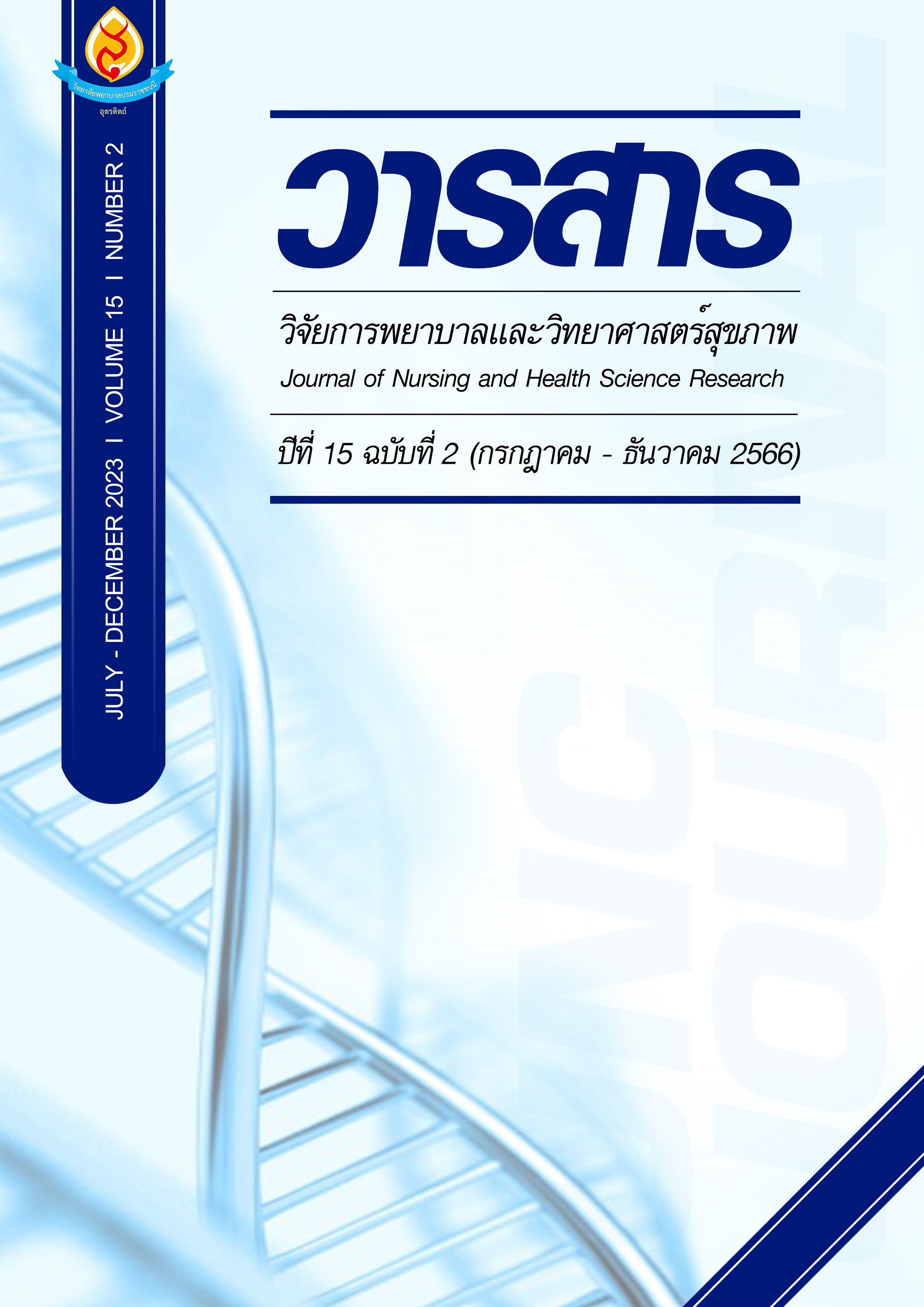ประสบการณ์ของผู้ป่วยวิกฤตที่ได้รับการรักษาด้วยออกซิเจนอัตราการไหลสูงผ่านทางจมูกหลังถอดท่อช่วยหายใจ
Main Article Content
บทคัดย่อ
วิจัยเชิงคุณภาพแบบบรรยายปรากฏการณ์นี้มีวัตถุประสงค์เพื่อบรรยายประสบการณ์ของผู้ป่วยวิกฤตที่ได้รับการรักษาด้วยออกซิเจนอัตราการไหลสูงผ่านทางจมูกหลังถอดท่อช่วยหายใจในหอผู้ป่วยหนักระบบทางเดินหายใจ ผู้ให้ข้อมูลจำนวน 12 ราย ได้รับการคัดเลือกแบบเฉพาะเจาะจง แนวทางการสัมภาษณ์แบบ กึ่งโครงสร้างได้รับการพัฒนาขึ้นเพื่อเก็บรวบรวมข้อมูลโดยการสัมภาษณ์แบบตัวต่อตัว ระหว่างเดือนธันวาคม พ.ศ. 2564 ถึงเดือนมิถุนายน พ.ศ. 2565 วิเคราะห์ข้อมูลเชิงคุณภาพด้วยวิธีการของจอร์จี
ผลการวิจัยพบว่าประสบการณ์ของผู้ป่วยวิกฤตที่อยู่ภายใต้การรักษาด้วยออกซิเจนอัตราการไหลสูงผ่านทางจมูกหลังถอดท่อช่วยหายใจ ประกอบด้วย 1) ความสุขสบาย ผู้ป่วยวิกฤตรู้สึกสุขสบายเพราะพวกเขาปราศจากความเจ็บปวดจากการใส่ท่อช่วยหายใจและรู้สึกหายใจได้สะดวกระหว่างใช้ออกซิเจนอัตราไหลสูง 2) ความไม่สุขสบาย คือ มีอาการแสบร้อนจมูก 3) อยู่กับความกลัวและกังวล ผู้ป่วยวิกฤตมีความกลัวและกังวลว่าอาการที่ตนเองเป็นอยู่จะแย่ลงและการใส่ท่อช่วยหายใจซ้ำ และ 4) การกำกับดูแล ผู้ป่วยวิกฤตต้องการการกำกับดูแลเกี่ยวกับปัญหาและภาวะแทรกซ้อนของการรักษาด้วยออกซิเจนอัตราไหลสูง
จากผลการวิจัยสามารถเป็นข้อมูลพื้นฐานเพื่อพัฒนาแนวทางการดูแลสำหรับผู้ป่วยวิกฤตและงานวิจัยที่เกี่ยวข้อง ได้แก่ การจัดการอาการสำหรับผู้ป่วยวิกฤตที่มีภาวะแทรกซ้อนจากการรักษาด้วยออกซิเจนอัตราการไหลสูงผ่านทางจมูก และการพัฒนาแนวปฏิบัติสำหรับพยาบาลในการดูแลผู้ป่วยวิกฤตที่อยู่ภายใต้การรักษาด้วยออกซิเจนอัตราการไหลสูงผ่านทางจมูกโดยคำนึงถึงปัญหาและความต้องการของผู้ป่วยวิกฤต
Article Details

อนุญาตภายใต้เงื่อนไข Creative Commons Attribution-NonCommercial-NoDerivatives 4.0 International License.
บทความหรือข้อคิดเห็นใดใดที่ปรากฏในวารสารวิจัยการพยาบาลและวิทยาศาสตร์สุขภาพ เป็นวรรณกรรมของผู้เขียน ซึ่งบรรณาธิการหรือสมาคมศิษย์เก่า ไม่จำเป็นต้องเห็นด้วย และบทความที่ได้รับการตีพิมพ์เผยแพร่ถือเป็นลิขสิทธิ์ของวารสารวิจัยการพยาบาลและวิทยาศาสตร์สุขภาพ
เอกสารอ้างอิง
Bräunlich, J., Köhler, M. & Wirtz, H. (2016). Nasal highflow improves ventilation in patients with COPD. International Journal of Chronic Obstructive Pulmonary Disease, 11, 1077-1085.
Cruz, R. F., Hart, N. & Kaltsakas, G. (2020). High-flow therapy: Physiological effects and clinical applications. Breathe, 16(4), 200224.
Drake, M. G. (2018). High-flow nasal cannula oxygen in adults: An evidence-based assessment. Annals of the American Thoracic Society, 15(2), 145-155.
Giorgi, A. (1985). Phenomenology and psychological research. Pittsburgh: Duquesne University Press.
Holloway, I. & Galvin, K. (2017). Qualitative research in nursing and healthcare. (4th ed.). West Sussex: Wiley.
Ischaki, E., Pantazopoulos, I. & Zakynthinos, S. (2017). Nasal high flow therapy: a novel treatment rather than a more expensive oxygen device. European Respiratory Review, 26, 170028.
Ko, R. E., Park, C., Nam, J., Ko, M. G., Na, S. J., Ahn, J. H., . . . Jeon, K. (2020). Effect of post-extubation high-flow nasal cannula on reintubation in elderly patients: a retrospective propensity score-matched cohort study. Therapeutic Advances in Respiratory Disease, 14, 1753466620968497.
Lodeserto, F. J., Lettich, T. M. & Rezaie, S. R. (2018). High-flow nasal cannula: Mechanisms of action and adult and pediatric indications. Cureus, 10(11), e3639.
Meyer, A. C., Spiesshoefer, J., Siebers, N. C., Heidbreder, A., Thiedemann, C., Schneider, H., . . . Boentert, M. (2020). Effects of nasal high flow on nocturnal hypercapnia, sleep, and sympathovagal balance in patients with neuromuscular disorders. Sleep & Breathing, 25, 1441–1451.
Nedel, W. L., Deutschendorf, C. & Moraes Rodrigues Filho, E. (2017). High-flow nasal cannula in critically ill subjects with or at risk for respiratory failure: A systematic review and meta-analysis. Respiratory Care, 62(1), 123-132.
Nishimura, M. (2015). For critically ill patients, Is high-flow nasal cannula oxygen delivery a suitable alternative to mechanical ventilation? Respiratory Care, 60(2), 307-308.
Nishimura, M. (2019). High-flow nasal cannula oxygen therapy devices. Respiratory Care, 64(6), 735-742.
Polit, D. F. & Beck, C. T. (2017). Essentials of nursing research: appraising evidence for nursing practice. (9th ed.). Philadelphia: Lippincott Williams & Wilkins.
Reed, J. M., Dodson, T. & Ferdig, R. E. (2020). High-flow nasal cannulas: Risks and benefits in response to COVID-19. Retrieved from https://www.myamericannurse.com/high-flow-nasal-cannulas-risks-and-benefits-in-response-to-covid-19/
Rittayamai, N., Chuariyakul, P., Promlee, N., Chailard, P., Chierakul, N. & Brochard, L. (2021). Hight-flow nasal cannula for patients with acute respiratory failure treated in a general medical ward: A prospective cohort study. Journal of the Medical Association of Thailand, 104(7), 1179-1186.
Storgaard, L., Weinreich, U. & Laursen, B. S. (2020). COPD patients’ experience of long-term domestic oxygen-enriched nasal high flow treatment: A qualitative study. Journal of Chronic Obstructive Pulmonary Disease, 17(2), 175–183.
Wang, K., Zhao, W., Li, J., Shu, W. & Duan, J. (2020). The experience of high-flow nasal cannula in hospitalized patients with 2019 novel coronavirus-infected pneumonia in two hospitals of Chongqing, China. Annals of Intensive Care, 10(1), 37.
Yu, Y., Qian, X., Liu, C., & Zhu, C. (2017). Effect of high-flow nasal cannula versus conventional oxygen therapy for patients with thoracoscopic lobectomy after extubation. Canadian Respiratory Journal, 7894631.


